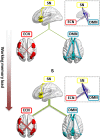Topologically Reorganized Connectivity Architecture of Default-Mode, Executive-Control, and Salience Networks across Working Memory Task Loads
- PMID: 25596593
- PMCID: PMC4785946
- DOI: 10.1093/cercor/bhu316
Topologically Reorganized Connectivity Architecture of Default-Mode, Executive-Control, and Salience Networks across Working Memory Task Loads
Abstract
The human brain is topologically organized into a set of spatially distributed, functionally specific networks. Of these networks, the default-mode network (DMN), executive-control network (ECN), and salience network (SN) have received the most attention recently for their vital roles in cognitive functions. However, very little is known about whether and how the interactions within and between these 3 networks would be modulated by cognitive demands. Here, we employed graph-based modularity analysis to identify the DMN, ECN, and SN during an N-back working memory (WM) task and further investigated the modulation of intra- and inter-network interactions at different cognitive loads. As the task load elevated, functional connectivity decreased within the DMN while increased within the ECN, and the SN connected more with both the DMN and ECN. Within-network connectivity of the ventral and dorsal posterior cingulate cortex was differentially modulated by cognitive load. Further, the superior parietal regions in the ECN showed increased internetwork connections at higher WM loads, and these increases correlated positively with WM task performance. Together, these findings advance our understanding of dynamic integrations of specialized brain systems in response to cognitive demands and may serve as a baseline for assessing potential disruptions of these interactions in pathological conditions.
Keywords: connectomics; default-mode network; executive-control network; module; salience network.
Published by Oxford University Press 2015. This work is written by (a) US Government employee(s) and is in the public domain in the US.
Figures






Similar articles
-
Altered coupling of default-mode, executive-control and salience networks in Internet gaming disorder.Eur Psychiatry. 2017 Sep;45:114-120. doi: 10.1016/j.eurpsy.2017.06.012. Epub 2017 Jul 12. Eur Psychiatry. 2017. PMID: 28756109
-
A Comprehensive Analysis of Connectivity and Aging Over the Adult Life Span.Brain Connect. 2016 Mar;6(2):169-85. doi: 10.1089/brain.2015.0345. Epub 2016 Jan 22. Brain Connect. 2016. PMID: 26652914
-
Interactions Among the Brain Default-Mode, Salience, and Central-Executive Networks During Perceptual Decision-Making of Moving Dots.Brain Connect. 2016 Apr;6(3):249-54. doi: 10.1089/brain.2015.0379. Epub 2016 Jan 27. Brain Connect. 2016. PMID: 26694702
-
Dysregulation within the salience network and default mode network in hyperthyroid patients: a follow-up resting-state functional MRI study.Brain Imaging Behav. 2020 Feb;14(1):30-41. doi: 10.1007/s11682-018-9961-6. Brain Imaging Behav. 2020. PMID: 30259292 Review.
-
Demystifying cognitive flexibility: Implications for clinical and developmental neuroscience.Trends Neurosci. 2015 Sep;38(9):571-8. doi: 10.1016/j.tins.2015.07.003. Trends Neurosci. 2015. PMID: 26343956 Free PMC article. Review.
Cited by
-
Altered functional association and couplings: Effective diagnostic neuromarkers for Alzheimer's disease.Front Aging Neurosci. 2022 Oct 13;14:1009632. doi: 10.3389/fnagi.2022.1009632. eCollection 2022. Front Aging Neurosci. 2022. PMID: 36313014 Free PMC article.
-
Infraslow closed-loop brain training for anxiety and depression (ISAD): a protocol for a randomized, double-blind, sham-controlled pilot trial in adult females with internalizing disorders.Trials. 2022 Nov 17;23(1):949. doi: 10.1186/s13063-022-06863-z. Trials. 2022. PMID: 36397122 Free PMC article.
-
Control networks and hubs.Psychophysiology. 2018 Mar;55(3):10.1111/psyp.13032. doi: 10.1111/psyp.13032. Epub 2017 Nov 28. Psychophysiology. 2018. PMID: 29193146 Free PMC article. Review.
-
Integration and segregation of large-scale brain networks during short-term task automatization.Nat Commun. 2016 Nov 3;7:13217. doi: 10.1038/ncomms13217. Nat Commun. 2016. PMID: 27808095 Free PMC article.
-
Accurate module induced brain network construction for mild cognitive impairment identification with functional MRI.Front Aging Neurosci. 2023 Feb 16;15:1101879. doi: 10.3389/fnagi.2023.1101879. eCollection 2023. Front Aging Neurosci. 2023. PMID: 36875703 Free PMC article.
References
-
- Batagelj V, Mrvar A. 1998. Pajek-program for large network analysis. Connections. 21:47–57.
-
- Blondel V, Guillaume J, Lambiotte R, Lefebvre E. 2008. Fast unfolding of communities in large networks. J Stat Mech. 2008:P10008.
-
- Bressler SL, Menon V. 2010. Large-scale brain networks in cognition: emerging methods and principles. Trends Cogn Sci. 14:277–290. - PubMed
-
- Buckner RL, Andrews-Hanna JR, Schacter DL. 2008. The brain's default network: anatomy, function, and relevance to disease. Ann NY Acad Sci. 1124:1–38. - PubMed
Publication types
MeSH terms
LinkOut - more resources
Full Text Sources
Other Literature Sources
Research Materials

